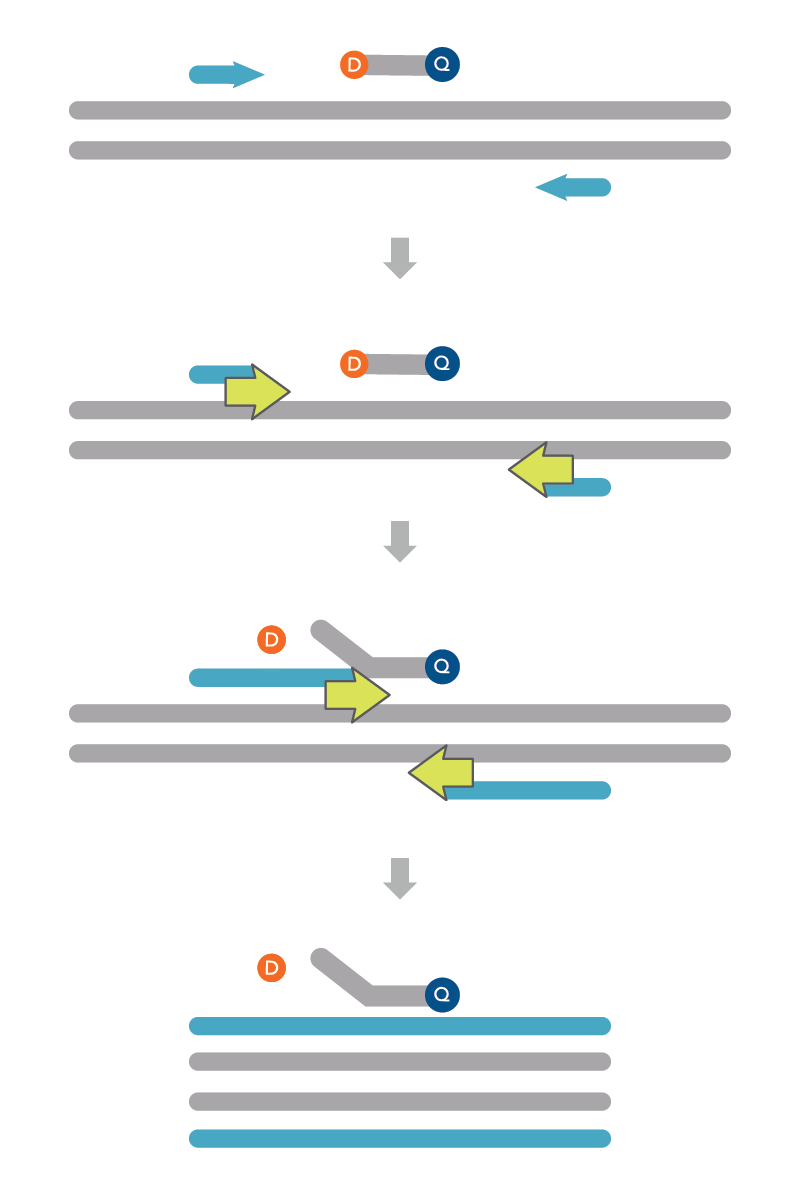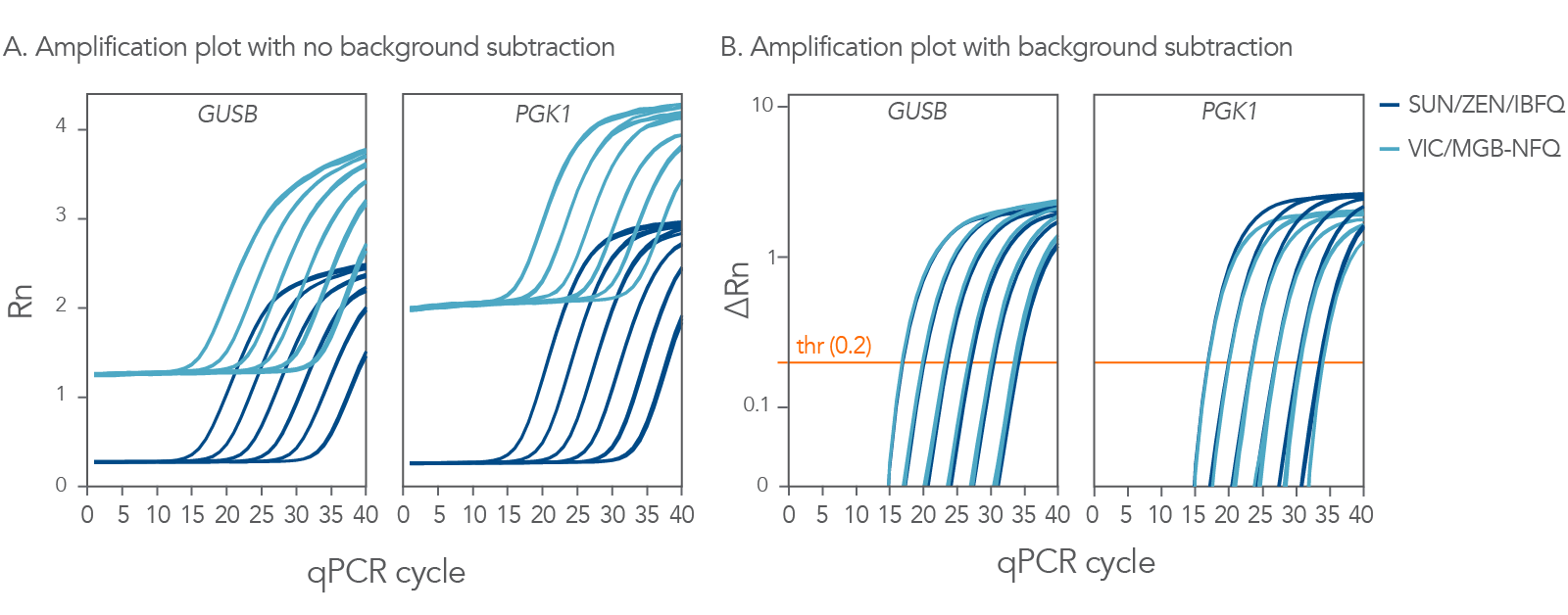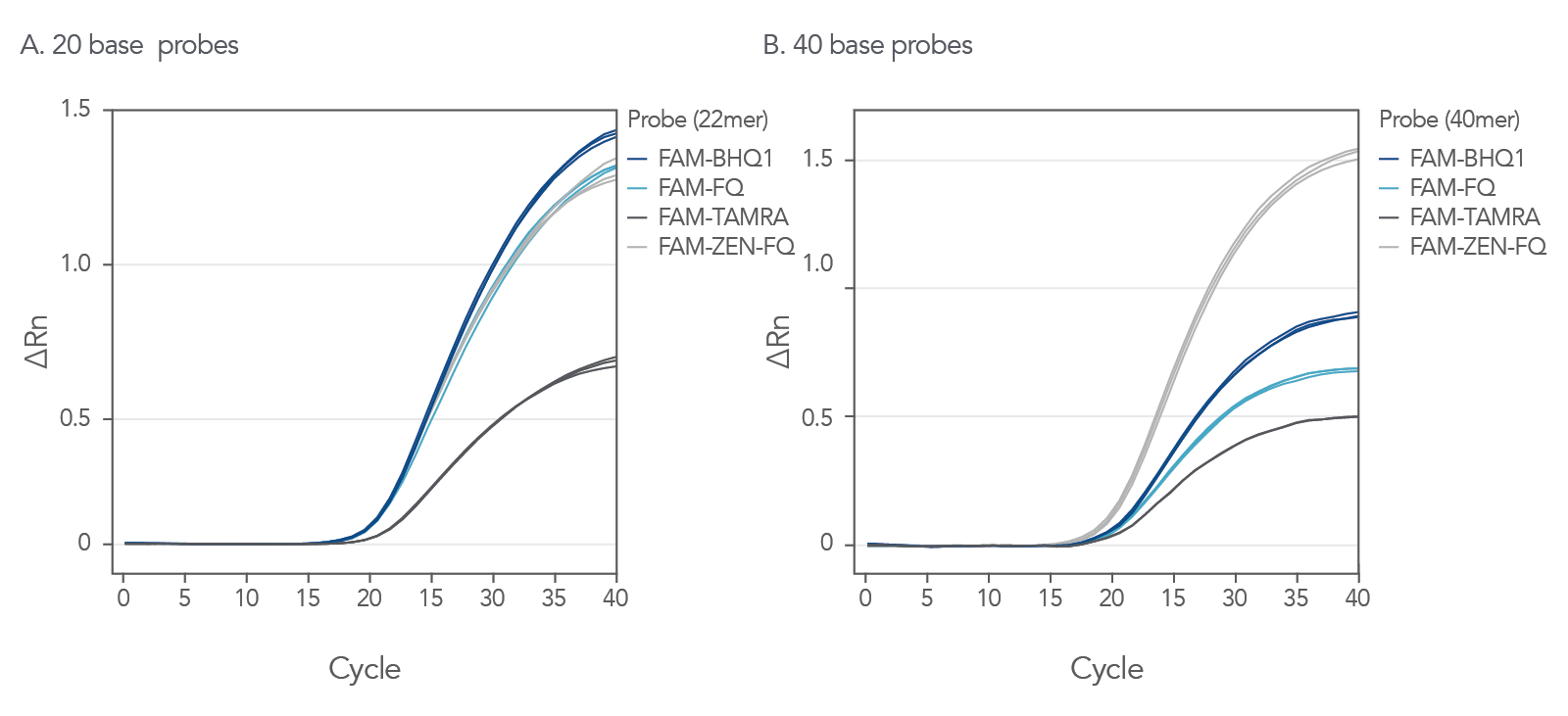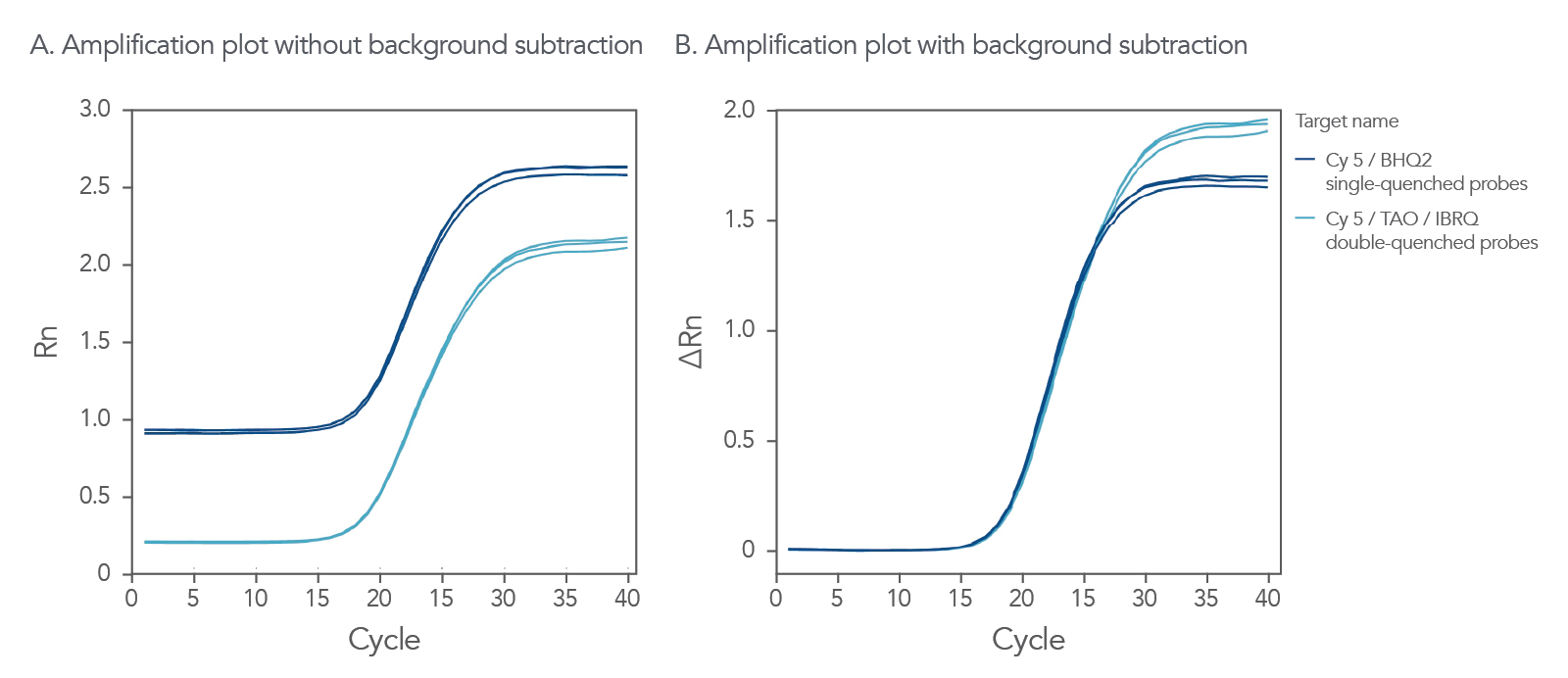PrimeTime™ qPCR Probes
Generate reliable, high-quality gene expression analysis data with double- and single-quenched fluorescent hydrolysis probes
PrimeTime qPCR Probes are 5′ nuclease probes, available with an assortment of reporter-dye combinations that are compatible with common qPCR instruments and that include several license-free combinations.
Ordering
- Select from a wide range of license-free dyes, including FAM, Yakima Yellow®, SUN™, HEX, Cy® 3, Texas Red®-X, and Cy® 5 dyes
- Reduce background signals, even with longer probes, when using ZEN™ or TAO™ Double-Quenched Probes
- Successfully multiplex using double-quenched probes
- Choose from the convenient 0.5–2.5 nmol packaging size for digital PCR (dPCR) platforms
- Achieve high efficiency of probe-based qPCR under fast or standard cycling conditions
- Minimize troubleshooting─PrimeTime qPCR Probes are quality controlled via electrospray ionization mass spectrometry (ESI-MS)* and HPLC-purified
* With the exception of mixed base oligos, which could potentially represent multiple sequences and therefore cannot be accurately evaluated by ESI-MS.
Yakima Yellow (YAK) is a registered trademark of EliTech Group, Cy is a registered trademark of Cytiva, and Texas Red is a registered trademark of Molecular Probes, Inc.
Choose from a wide variety of synthesis scales, dyes, and quenchers, including several license-free options. Prices and estimated turnaround times depend on the degree of complexity. For more information on dyes and quenchers, see Product details. Guides for compatible dye and quencher combinations are available in the Resources tab. For multiplex applications, consult the PrimeTime Multiplex Dye Selection Tool.
PrimeTime qPCR Probes—Standard level
The minimum guarantees are listed for probes that are 15–35 bases in length.
| |||||||||||||||||||||||||||||||||||||||||||||||||||||||||||||||||
* ZEN/Iowa Black™ FQ is a double-quenched probe, which provides superior performance compared to traditional single-quenched probes. For more information, download the PrimeTime Custom qPCR Probes Flyer.
PrimeTime qPCR Probes—Complex level
The minimum guarantees are listed for probes of 15–35 bases.
|
* ZEN/Iowa Black FQ is a double-quenched probe, which provides superior performance compared to traditional single-quenched probes. For more information, download the PrimeTime Custom qPCR Probes Flyer.
TEX™ fluorophore and JOE are trademarsk of ThermoFisher; TYE™ is licensed from ThermoFisher; Texas Red® is a registered trademark of Molecular Probes, Inc.
PrimeTime Mini/Eco qPCR Probes
Available with a 5′ FAM and the option of a 3′ IBFQ quencher alone or in combination with the internal ZEN quencher.
|
* ZEN/Iowa Black FQ is a double-quenched probe, which provides superior performance compared to traditional single-quenched probes. For more information, download the PrimeTime Custom qPCR Probes Flyer.
PrimeTime Express qPCR Probes
HPLC purified. Availabile for lengths of 18–35 bases. Shipped dry. Minimum guarantee of 5 nmol.
|
* ZEN/Iowa Black™ FQ is a double-quenched probe, which provides superior performance compared to traditional single-quenched probes. For more information, download the PrimeTime Custom qPCR Probes Flyer.
Product Details
Double-Quenched Probes
While traditional probes have approximately 20–30 bases between the fluorophore and the quencher, the internal ZEN or TAO Quencher decreases that length to only 9 bases (Figure 1). This shortened distance, particularly when combined with the traditional 3′ end quencher, leads to a more thorough quenching with lower background and enables the use of longer probes for designing in AT-rich target regions. In addition to the significantly decreased background, Double-Quenched Probes also provide consistently reduced Cq values and improved precision when compared to traditional probes. Use of Double-Quenched Probes can allow you to experience increased precision in your qPCR experiments.
- ZEN Double-Quenched Probes─ZEN Double-Quenched Probes contain a 5′ fluorophore, 3′ Iowa Black FQ (IBFQ) quencher, and proprietary, internal ZEN quencher. The most commonly supplied 5′ fluorophores includes FAM, TET, Yakima Yellow, SUN, or HEX.
- TAO Double-Quenched Probes─TAO Double-Quenched Probes are available with a 5′ Cy 5 fluorophore, 3′ Iowa Black RQ (IBRQ) quencher, and proprietary, internal TAO quencher.
For more information download the PrimeTime Custom qPCR Probes Flyer.
PrimeTime Mini qPCR Probes
The smaller scale and lower price of PrimeTime Mini qPCR probes make them ideal for digital PCR (dPCR) applications, testing a new probe for gene expression or genotyping applications, or for testing the conversion to FAM/IBFQ and FAM/ZEN/IBFQ from other FAM-related quenchers. Mini probes are offered with 5′ FAM, SUN, HEX, and Cy 5 fluorophores. Quenchers include 3′ IBFQ alone, double-quenched internal ZEN with 3' IBFQ, or double-quenched internal TAO with 3' IBRQ (Cy 5 only).
PrimeTime Eco qPCR Probes
The PrimeTime Eco qPCR Probe is the ideal scale when you need to perform ~500 reactions for gene expression analysis or genotyping. The combination of medium scale and low cost is ideal for initial screening of large sample sets. Eco scales are also amenable to dPCR applications. Eco qPCR Probes are available as double-quenched probes with 5′ FAM, SUN, HEX, and Cy 5 fluorophores. Quenchers include 3′ IBFQ alone, double-quenched internal ZEN with 3' IBFQ, or double-quenched internal TAO with 3' IBRQ (Cy 5 only).
PrimeTime Express qPCR Probes
PrimeTime Express qPCR Probes are HPLC-purified qPCR probes that are assessed by mass spectrometry for quality control, with traces provided on our website free of charge*. Due to the turnaround time, these probes have limited dye-quencher combinations and synthesis scales.
* With the exception of mixed base oligos, which could potentially represent multiple sequences and therefore cannot be accurately evaluated by ESI-MS.
Selecting the correct reporter dye and quencher
- Reporter dyes: The correct reporter dye will depend on the type of instrument you are using and the compatibility of the dye with the instrument. Please see the instrument compatibility table for a list of reporter dyes compatible with common instrumentation. For multiplexing applications, we recommend using reporter dyes with the least amount of spectral overlap. For assistance in selecting multiplex dye combinations, use our Multiplexing Dye Selection Tool, which helps you select dyes based on what instrument you have. As an additional reference, for a list of selected IDT dyes and quenchers, please see the dye and quencher wavelength figure and the instrument compatibility table.
- Quenchers: Traditional dark quenchers absorb broadly and do not emit light, which allows for the use of multiple reporter dyes with a given quencher. This characteristic allows for expanded options for multiplex assays. Dark quenchers are compatible with a broad range of image analysis instruments. These double-quenched probes are an improvement over traditional dual-labeled probes and have consistently low background, reduced Cq values, improved precision, and enable the use of longer probes for design in AT-rich regions. Double-quenched probes are available with a variety of fluorophores, including SUN, FAM, HEX, TET, Yakima Yellow, and Cy 5. For more information download the PrimeTime Custom qPCR Probes flyer. We supply commonly used dark quenchers as well as the proprietary dark quenchers, Iowa Black FQ, Iowa Black RQ, and the internal ZEN Quencher. TAMRA is also a quencher option for a FAM reporter dye.
- Summary tables:
Overview of 5′ nuclease assays
Step 1—the primers and probe hybridize in a sequence-dependent manner to the complementary DNA strand. Because the probe is intact, the fluorophore and quencher are in close proximity and the quencher absorbs fluorescence emitted by the fluorophore.
Step 2—the polymerase extends from the primers and begins DNA synthesis.
Step 3—the polymerase reaches the probe and the exonuclease activity of the polymerase cleaves the hybridized probe. As a result of cleavage, the fluorophore is separated from the quencher and fluoresces.
Step 4—the fluorescence is measured by the real-time instrument.
These steps are repeated for each PCR cycle. When using intercalating dyes, such as SYBR Green I (Thermo Fisher Scientific), primer-dimers and non-specific products will also contribute to fluorescence. In contrast, the 5′ nuclease assay is specific and fluorescence will only be produced for the DNA sequence to which the probe and primers hybridize.
Product Data
Dye-quencher combinations
To demonstrate the performance of different dye-quencher combinations, we tested a dilution series and showed that the PCR efficiency and R2 values were similar across all dye-quencher combinations available (Figure 2).
Figure 2. Demonstrated assay performance with multiple dye–quencher combinations. A gBlocks™ Gene Fragment dilution series of the HPRT gene was used to test different dye-quencher combinations. The data show PCR efficiency and R2 values close to 1 across all dye/quenchers available for PrimeTime qPCR Assays. All reactions were run using the PrimeTime Gene Expression Master Mix under standard two step cycling conditions 95°C for 3 min, (95 °C for 15 sec + 60°C for 1 min) X 40 on the QuantStudio™ 7 Flex (Thermo Fisher Scientific) 386 well format. Reactions were 10 µL in volume and contained 500 nM primers and 250 nM probe. The PrimeTime Gene Expression Master Mix was used with low ROX reference dye.
Figure 3. PrimeTime qPCR Probes labeled with SUN fluorophores deliver comparable performance to VIC®/MGB-NFQ probes. A double-quenched SUN/ZEN/IBFQ probe was compared to a VIC/MGB-NFQ probe in a qPCR assay for GUSB and PGK1. gBlocks Gene Fragments with sequences identical to GUSB and PGK1 were analyzed over 6 sequential 10‑fold dilutions (102–107 copies). Normalized fluorescence values were plotted (A) including and (B) subtracting background fluorescence. Cq values were comparable, and the final R2 value for both standard curves equaled 0.999. Each reaction was run in triplicate using the PrimeTime Gene Expression Master Mix, and data was generated using the QuantStudio™ 7 Flex Real-Time PCR System software (Thermo Fisher Scientific) with the following PCR cycling conditions: 10 min 95°C, 40X (15 sec 95°C, 1 min 60°C).
VIC is a registered trademark of Applied Biosystems/LifeTechnologies, Inc.
ZEN Double-Quenched Probes
Achieve maximum quenching for probes as long as 40 bases with ZEN Double-Quenched Probes (Figure 4). Effective quenching means more effective designs, even for AT-rich targets.
Figure 4. ZEN Double-Quenched Probes maintain low background signal with increasing probe length. Probes of either 20 or 40 bases with 4 different quenchers run in 3 replicate reactions with each probe type run with a gBlocks Gene Fragment template (2 x 105 copies) and PrimeTime Gene Expression Master Mix on the QuantStudio™ 7 qPCR instrument (Thermo Fisher Scientific).
TAO Double-Quenched Probes
In qPCR experiments, TAO Double-Quenched Probes exhibit decreased background (Figure 5A) and increased signals (Figure 5B) compared to single-quenched probes.
Figure 5. Increased signal to noise ratio from TAO double-quenched probes. Three qPCR assays using the same primer and probe sequences were designed to amplify SFRS9. The assays differed by the quenchers on the probes—the 5′ Cy 5 fluorophore was combined with either TAO and Iowa Black RQ (RQ) quenchers (dark blue, double-quenched probe)or a Black Hole Quencher-2 (BHQ2) quencher (light blue, single-quenched probe). A gBlocks Gene Fragment encoding for SFRS9 sequences was used as template in a 10 µL PCR on a Quantstudio™ 7 with the PrimeTime Gene Expression Mastermix, and the following cycling conditions: 10 min. 95°C; 45 X (15 sec. 95°C, 1 min. 60°C).
Services
Formulation
We can provide custom formulation for PrimeTime qPCR Probes. Contact us for assistance.
GMP and OEM
If you require probes that are ISO 13485:2016 certified, or if you are interested in our third-party manufacturing services, please click here.
Resources
Frequently asked questions
How does the PrimeTime™ One-Step RT-qPCR Master Mix compare with one-step master mixes from other manufacturers?
How long can I leave my qPCR master mix (containing PrimeTime™ Gene Expression Master Mix) at room temperature and still generate consistent results?
The stability of PrimeTime Gene Expression Master Mix makes it ideal for overnight PCR runs and high throughput experiments using robotic liquid handling systems.
Reliable results have been obtained when the qPCR was run directly after setup or after the reactions were maintained at room temperature for up to 72 hr.
Download the white paper, Ambient shipping of PrimeTime Gene Expression Master Mix for more data.
Why does the reference dye come in a separate tube from the PrimeTime™ Gene Expression Master Mix?
We provide a separate tube of reference dye so that you may use the PrimeTime Gene Expression Master Mix on reference dye-dependent or dye-independent instruments.
Also, the separate tube of reference dye provides a way to add a high or low dye concentration to the master mix, depending on the requirements of your instrument.
Does the PrimeTime™ Gene Expression Master Mix use a hot-start polymerase?
Yes, it uses an antibody-mediated, hot-start polymerase. During the initial denaturation step of qPCR cycling, polymerase activity is unblocked when the polymerase is released from the antibody.
This hot-start polymerase enhances reaction precision of the qPCR by avoiding non-specific amplification of DNA and primer dimer formation. It is therefore critical to follow the cycling conditions provided in the PrimeTime Gene Expression Master Mix Protocol.
Is the Primetime™ Gene Expression Master Mix compatible with different real time PCR instruments or systems?
Reference dye is provided in a separate tube, so you may add it to the master mix at the levels required by your real-time PCR instrument.
How much reference dye should I add to the Primetime™ Gene Expression Master Mix?
The amount of reference dye that should be added to the PrimeTime Gene Expression Master Mix depends on which real-time PCR system you are using.
A table that details how much reference dye to add is provided in the PrimeTime Gene Expression Master Mix Protocol.
Does IDT offer VIC® probes for qPCR?
IDT offers the SUN™ dye, which is our product offering for the VIC dye (Thermo Fisher Scientific).
More information about probes labeled with the SUN fluorophore can be found on the PrimeTime™ qPCR probes page or the SUN fluorophore Decoded™ article.
How should I determine the annealing temperature for a probe-based qPCR assay? Should I select a melting temperature midway between my primer and probe melting temperatures (Tm)?
When performing qPCR it is ideal to have your probe Tm about 5−10 degrees higher than your primer Tm. The annealing temperature should be set 3−5 degrees lower than the lowest primer Tm.
Use this as a general guideline, but note that optimization may still be necessary.
What qPCR products does IDT ship at ambient temperature?
We ship PrimeTime™ Gene Expression Master Mix, PrimeTime qPCR assays, and other oligonucleotide products at ambient temperature.
Will phosphorothioate (PS) modifications on the ends of PCR primers provide nuclease resistance, and thus result in a longer half-life for the PCR product when transfected into a cell?
Phosphorothioate bonds (PS bonds) increase oligonucleotide resistance to exonuclease degradation. For single-stranded oligos, nuclease-resistance is highest when every phosphodiester bond is changed to a PS bond.
In general, we recommend at least 3 PS bonds on both 5' and 3' ends of the oligo, though more PS bonds will give greater exonuclease resistance.
Note that PCR primers with PS bonds at both ends will still result in double-stranded (ds) PCR products with PS bonds only at the 5' ends of each product strand. While protected from 5' to 3' nuclease activity, because these dsDNAs lack PS bonds at the 3' strand ends, exonucleases with 3' to 5' activity will still be able to degrade them.
Why do my primers have deleted 3' bases in the amplified fragment when I use a proofreading enzyme for PCR?
Proofreading polymerases (Pfu, Diamond Taq®, etc) have been shown to remove 3' bases from PCR primers [1].
If you experience this problem, you can protect your primer from degradation by adding one or more phosphorothioate bonds to the 3' end of your primer.
Also make sure to add the enzyme last, after the addition of dNTPs, in your PCR to minimize the risk of this issue taking place.
Reference
1. Skerra A. Phosphorothioate primers improve the amplification of DNA sequences by DNA polymerases with proofreading activity. Nucleic Acids Res. 1992;20(14):3551-3554.
Which dyes are compatible with my thermal cycler?
To determine what dyes are compatible with your instrument, download our Real-time qPCR assay design guide or take a look at the PrimeTime™ Multiplex Dye Selection Tool.
Which dyes are available for use with the IDT ZEN™ quencher?
Currently, the IDT ZEN quencher is available with FAM, HEX, TET, Yakima Yellow® (ELITech Group), JOE™ (Thermo Fisher Scientific), MAX™, and SUN™ fluorophores. Double-quenched probes have significantly lower background fluorescence, especially for longer probes.
The ZEN quencher is available on PrimeTime™ qPCR Probes and on the probes supplied with PrimeTime qPCR Probe Assays. For any special oligonucleotide requests that include the ZEN quencher but are not found on our website (non-catalog requests), please contact us.
For more information, see our DECODED™ article, Double-quenched probes increase qPCR sensitivity and precision.
Where on a nucleotide are Cy® dyes attached?
5′ Cy dyes are attached to the 5' hydroxyl group of the sugar via a phosphodiester bond.
3' Cy dyes are attached to the 3' hydroxyl group of the sugar via a phosphodiester bond.
Internal Cy dyes are attached to the backbone via the phosphodiester bonds of the bases between which the dyes occur.
When will my oligos be shipped?
IDT oligos have various estimated ship dates depending on product type and composition. Oligos added to the shopping cart will show an estimated ship date for each line item.
Once the order is placed, this estimated ship date can be found on the order confirmation email as well as in the order history of your web account. You can find the order history at idtdna.com/site/orderstatus/orderstatus.
Select the order number you wish to review, and the status and estimated ship date of each line item will be shown.
IDT will email you a confirmation when your order has been shipped. This shipping confirmation will include the tracking number of the package, which you can use to monitor the status of your shipment. If you have additional questions about your order, please contact us.
When preparing the qPCR reaction mix should I thaw or keep reagents (such as the Primetime™ Gene Expression Master Mix) on ice?
It is good practice, but not necessary to thaw or keep reagents on ice. We see no difference in results between reaction mixes prepared with the PrimeTime™ Gene Expression Master Mix that were used directly after thawing vs. those kept at room temperature for up to 24 hours.
PrimeTime Gene Expression Master Mix also shows exceptional temperature stability, even after a heat stress test (up to 8 hr at 55°C). Review the data in our white paper, Ambient shipping of PrimeTime Gene Expression Master Mix.
What type of purification should I choose for my qPCR primers?
Standard desalting is the recommended purification for qPCR primers.
What tools does IDT provide to design multiplex qPCR assays?
Use the free IDT OligoAnalyzer™ software to help ensure that primer and probe sets lack hairpins and homo- and heterodimer interactions. From there, you can link directly to the NCBI BLAST™ tool to further analyze possible sequence interactions. For help with using the BLAST tool, see Using BLAST to find primers—Tips from IDT.
For more information on setting up multiplex qPCR assays, see the article Recommended dye combinations for multiplex qPCR.
What is the structure of the ZEN™ internal quencher?
What is the stability of fluorescently labeled oligos and their fluorescent modifications?
The stability of fluorescently labeled oligos and fluorophore function is similar to the stability of a standard oligo.
IDT recommends oligos that are to be stored long term should be stored frozen at –20°C. If the oligos are going to be resuspended, storage in a TE buffer such as IDTE (10 mM Tris, 0.1 mM EDTA, pH 7.5–8.0) is better than using water (non-DEPC treated). The impact from the type of storage medium used is marginal at –20°C, but becomes more important at higher temperatures (see the DECODED™ article, Storing oligos: 7 things you should know, for the data).
With fluorophores, it’s important to remember that exposure to natural light or ozone can negatively impact stability. If fluorescently modified oligos will be exposed to sustained light, protective cover from the lighting source (e.g., using brown tubes and/or foil covering) should be considered.
Related products
PrimeTime™ qPCR Probes Citations
GMP refers to products manufactured under ISO 13485: 2016 QMS. Purchaser is solely responsible for all decisions regarding the use of these products and any associated regulatory or legal obligations for their legal marketing.
















